Why Should I Bring my Pet to Willows for Treatment of Hip Dysplasia?
Willows is one of Europe’s leading small animal Orthopaedic referral centres treating over 1000 new patients a year. Our state-of-the-art hospital is led by internationally renowned Certified Specialists committed to providing the highest standards of care. Our team of Orthopaedic Specialists have considerable collective experience of treating pets with hip dysplasia.
Our Orthopaedic Surgeons are supported by our multi-disciplinary team of Specialists across a number of disciplines including; Anaesthesia, Diagnostic Imaging and Emergency and Critical Care. Willows has a large dedicated team of Nurses and clinical support staff available 24 hours a day, every day of the year to provide the best possible care for your pet.
What is Hip Dysplasia?
Hip dysplasia means abnormal development of the hip joint which unavoidably leads to the development of arthritis (osteoarthritis). The hip dysplasia, the secondary osteoarthritis, or both, may cause hip pain for a dog.
What is Hip Dysplasia?
Hip dysplasia is a genetic disorder caused by the combination of genes from the dog’s parents. During the first few months of life, as the hips are developing, they become unstable. As a result the ball (femoral head) and socket (acetabulum) move apart when weight bearing. This causes abnormal forces on the soft bones, which leads to the ball becoming flattened and the socket becoming shallow. The process is self-perpetuating and causes damage to the joint cartilage covering of the bones. Cartilage damage is a key feature of the osteoarthritis.

What are the Signs of Hip Dysplasia?
Hip dysplasia is a common condition, especially in large breed dogs. The key signs are stiffness and lameness affecting the back legs often after lying down or following exercise. Dogs will also often have difficulty rising and a reluctance to jump or exercise. Clinical signs tend to develop when the dog is young and growing (five to ten months of age) or as young adult (perhaps a few years of age). When growing, it is the instability of the hip that causes the pain whereas in adult dogs it is the osteoarthritis which results in discomfort.
Fig 1: X-ray showing normal hips
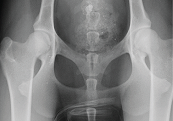
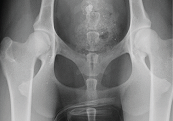
How is Hip Dysplasia Diagnosed?
Examination may reveal muscle wastage (atrophy), especially over the hips. Manipulation of the hip joints may cause pain and instability may be visible. X-rays are necessary to diagnose hip dysplasia, allowing the severity of the abnormal joint development and presence of secondary osteoarthritis to be assessed.
Fig 2: X-ray showing severe hip dysplasia
What Treatments are Available for Hip Dysplasia?
The majority of dogs with hip dysplasia can be treated satisfactorily without the need for surgery. Exercise often needs to be controlled to some degree and each dog will have its own threshold of duration and type of activity, beyond which hip pain may increase. Hydrotherapy and physiotherapy may be beneficial. Dogs that are overweight benefit from being placed on a diet. Painkillers may be required to make the dog more comfortable. Long-term drug therapy should be avoided if at all possible in view of potential side effects, where alternative and effective treatment options are available.
Some dogs with hip dysplasia fail to respond satisfactorily to medical treatment and in these dogs surgery may be indicated. There are two forms of surgery for hip dysplasia:

Reconstructive Surgery
In some growing dogs the abnormal hip joint may be reconstructed to make it more stable. This involves cutting the pelvis and rotating the cup over the ball. The rotated section is secured in the new position with a specially designed bone plate and screws. Either a Triple Pelvic Osteotomy (TPO) or a Double Pelvic Osteotomy (DPO) can be performed. Reconstructive surgery has the advantage of maintaining the dog’s own joint tissues and hopefully reducing the development of osteoarthritis. Unfortunately, many young dogs with hip dysplasia are not good candidates for reconstructive surgery.
Fig 3: X-ray showing triple pelvic osteotomy
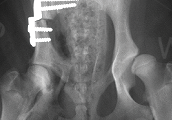
Salvage Surgery
Adult dogs with hip dysplasia and secondary osteoarthritis that don’t to respond to medical treatment may require salvage hip surgery with the option to replace the hip with an artificial one (Total Hip Replacement) or to remove the ball (femoral head removal or excision arthroplasty).
Total Hip Replacement (THR) generally results in significantly better limb function compared to femoral head removal with a quicker recovery. There are however some potential complications that need to be considered. With modern systems Total Hip Replacement can be performed successfully in nearly all sizes of patients. Total Hip Replacement surgery involves replacing the painful joint with a plastic cup and a metal ball (acetabular and femoral prostheses). Care following THR surgery is critical to reduce the possibility of complications, such as dislocation of the prostheses. A rapid reduction in joint pain and improvement in limb function are to be expected.
Femoral head removal provides a ‘false joint’ where the limb is supported on the pelvis by scar tissue and the surrounding muscles. Recovery following surgery is slow and the limb ends up slightly shorter. Aftercare, especially physiotherapy and hydrotherapy, is very important
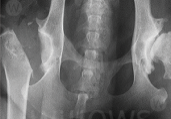
Fig 4: X-ray showing femoral head removal
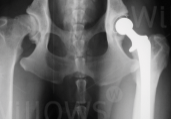
Fig 5: X-ray showing total hip replacement
What can I Expect if my Pet is Treated for Hip Dysplasia?
The outlook for patients with hip dysplasia and the associated osteoarthritis is generally good. Many dogs can be managed successfully with medical treatment. Those that fail to respond satisfactorily may require reconstructive procedures or salvage surgery such as Total Hip Replacement. The outcome of these procedures is generally very good.
To save this page as a PDF, click the button and make sure “Save as PDF” is selected.
Orthopaedics
Find out more
To assist owners in understanding more about Orthopaedics we have put together a range of information sheets to talk you through the some of the more common orthopaedic conditions seen and treated by our Specialists.

